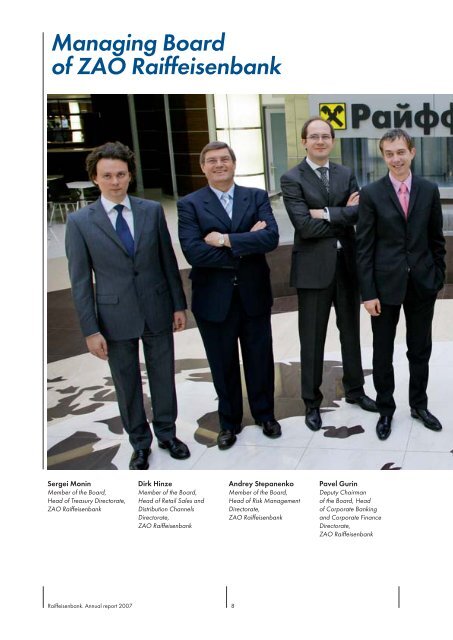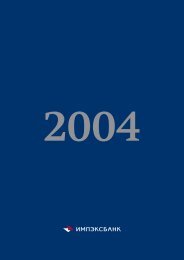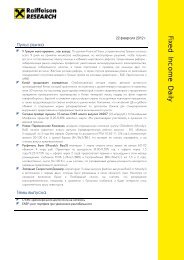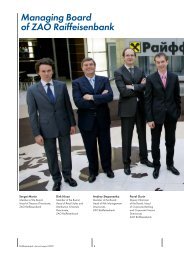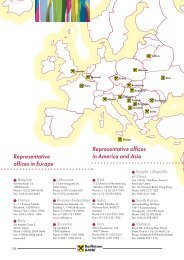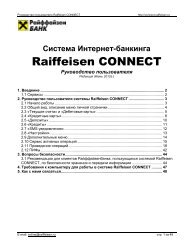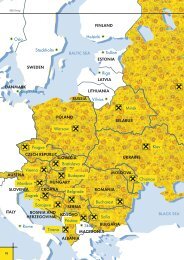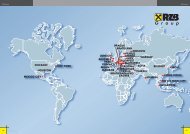Managing Board of ZAO Raiffeisenbank
Managing Board of ZAO Raiffeisenbank
Managing Board of ZAO Raiffeisenbank
You also want an ePaper? Increase the reach of your titles
YUMPU automatically turns print PDFs into web optimized ePapers that Google loves.
<strong>Managing</strong> <strong>Board</strong><br />
<strong>of</strong> <strong>ZAO</strong> <strong>Raiffeisenbank</strong><br />
Sergei Monin<br />
Member <strong>of</strong> the <strong>Board</strong>,<br />
Head <strong>of</strong> Treasury Directorate,<br />
<strong>ZAO</strong> <strong>Raiffeisenbank</strong><br />
Dirk Hinze<br />
Member <strong>of</strong> the <strong>Board</strong>,<br />
Head <strong>of</strong> Retail Sales and<br />
Distribution Channels<br />
Directorate,<br />
<strong>ZAO</strong> <strong>Raiffeisenbank</strong><br />
Andrey Stepanenko<br />
Member <strong>of</strong> the <strong>Board</strong>,<br />
Head <strong>of</strong> Risk Management<br />
Directorate,<br />
<strong>ZAO</strong> <strong>Raiffeisenbank</strong><br />
Pavel Gurin<br />
Deputy Chairman<br />
<strong>of</strong> the <strong>Board</strong>, Head<br />
<strong>of</strong> Corporate Banking<br />
and Corporate Finance<br />
Directorate,<br />
<strong>ZAO</strong> <strong>Raiffeisenbank</strong><br />
<strong>Raiffeisenbank</strong>. Annual report 2007<br />
8
Johann Jonach<br />
Chairman <strong>of</strong> the <strong>Managing</strong><br />
<strong>Board</strong>, <strong>ZAO</strong> <strong>Raiffeisenbank</strong><br />
Christoph Schoefboeck<br />
Member <strong>of</strong> the <strong>Board</strong>, Head<br />
<strong>of</strong> Operations and<br />
IT Directorate,<br />
<strong>ZAO</strong> <strong>Raiffeisenbank</strong><br />
Roman Vorobiev<br />
Member <strong>of</strong> the <strong>Board</strong>,<br />
Head <strong>of</strong> Consumer Banking<br />
Directorate,<br />
<strong>ZAO</strong> <strong>Raiffeisenbank</strong><br />
Alexandre Ouchakov<br />
Member <strong>of</strong> the <strong>Board</strong>,<br />
Head <strong>of</strong> Economic<br />
Security, Assets Recovery<br />
and Compliance Control<br />
Directorate,<br />
<strong>ZAO</strong> <strong>Raiffeisenbank</strong><br />
<strong>Managing</strong> <strong>Board</strong> <strong>of</strong> <strong>ZAO</strong> <strong>Raiffeisenbank</strong><br />
9
Kaliningrad<br />
10:00<br />
11:00 12:00 13:00<br />
14:00<br />
In the rythm <strong>of</strong> the working day
15:00<br />
16:00 17:00 18:00 19:00<br />
20:00
Russia:<br />
Economic<br />
Prospects<br />
As the Russian economy continued its commodity-driven boom<br />
in 2007, the government gradually shifted its priority from stabilization<br />
to stimulating growth. A major development was growing<br />
investment in non-service sectors, which helped Russia evade<br />
the downturn that struck the global economy in the second half<br />
<strong>of</strong> the year. The flipside <strong>of</strong> the investment boom was high inflation,<br />
which has become one <strong>of</strong> the government’s biggest challenges.<br />
Economic growth<br />
Last year Russia showed resilience in the face <strong>of</strong> a challenging<br />
global environment to post stellar economic growth, estimated<br />
at 8.1%. Production increased 6.3%, mainly due to industrial<br />
growth, while capital expenditures grew by some 21% on significant<br />
investment in non-service sectors <strong>of</strong> the economy. In 2007,<br />
household incomes swelled more than 15%, which in turn bolstered<br />
retail growth. The two pillars <strong>of</strong> the Russian boom, investment<br />
and consumption growth, both appear resistant to growing<br />
international instability.<br />
Inflation<br />
Inflation, which climbed to 11.9% in 2007 from 9% in 2006,<br />
was a major disappointment. The inflation rate was fuelled by<br />
growing food and commodities prices as well as a record inflow<br />
<strong>of</strong> foreign capital in the first six months <strong>of</strong> the year and the easing<br />
<strong>of</strong> monetary policy in the second. The government was left<br />
with relatively few tools to fight the swelling prices as the fear <strong>of</strong><br />
damaging exports left the government little room to strengthen<br />
the ruble.<br />
Budget policy<br />
The 2007 budget enjoyed a surplus <strong>of</strong> RUR 2 trillion, or 6.1%<br />
<strong>of</strong> GDP, as the average oil price reached USD 69.3 per barrel,<br />
comfortably above the planned USD 61. Russia made advance<br />
foreign debt payments, although they fell well short <strong>of</strong> those made<br />
in 2005-2006. As a result, Russia ended the year as a net-creditor.<br />
The USD 156 billion Stabilization Fund was more than triple<br />
the country’s USD 37 billion foreign debt, according to 2007<br />
figures.<br />
Currency policy<br />
Despite growing inflationary pressure, high commodity prices<br />
and record capital inflows led to a strengthening <strong>of</strong> the ruble<br />
<strong>of</strong> about 1.4% against a dollar-euro currency basket. Ruble<br />
appreciation was then dampened because <strong>of</strong> fears <strong>of</strong> cutting<br />
growth, especially in the raw material sectors. Towards<br />
<strong>Raiffeisenbank</strong>. Annual report 2007<br />
12
the end <strong>of</strong> the year, the Central Bank insisted that the scope<br />
for strengthening the ruble to control inflation had been practically<br />
exhausted. Over the 12 months the ruble strengthened<br />
by 5.7% in real terms, significantly less than the 7.4% posted<br />
in 2006.<br />
Balance <strong>of</strong> payments<br />
Record growth in direct foreign investment dominated the balance<br />
<strong>of</strong> payments as the cumulative inflow <strong>of</strong> private capital<br />
reached around USD 82 billion, almost double the figure for<br />
2006. As a result, the gold holdings <strong>of</strong> the Central Bank increased<br />
by over USD 172 billion over the year to reach a record<br />
USD 476 billion.<br />
Money market<br />
As the credit crunch hit global markets hard towards the end<br />
<strong>of</strong> 2007, the Central Bank took a number <strong>of</strong> steps to maintain<br />
domestic liquidity. In particular, it extended the selection <strong>of</strong> refinancing<br />
tools <strong>of</strong>fered to banks, most importantly repo agreements.<br />
In the autumn, liquidity levels in the banking sector became<br />
unstable due to the shortage <strong>of</strong> external funding for the<br />
Russian banks. However, by the end <strong>of</strong> the year the situation<br />
had improved and the banking system demonstrated its ability<br />
to survive external shocks. However, a recurrence <strong>of</strong> episodes <strong>of</strong><br />
instability should not be ruled out considering the relatively high<br />
degree <strong>of</strong> integration between the Russian market and the global<br />
financial system.<br />
2008 forecast<br />
Relative to other emerging economies, Russia is less vulnerable to<br />
global economic problems, as its growth is primarily fuelled by<br />
internal demand. The principle source <strong>of</strong> growth in 2008 is likely<br />
to be increases in capital expenditure and investment in infrastructure.<br />
The state funds and development institutes that have already<br />
been established for this purpose should become a major source<br />
<strong>of</strong> financing.<br />
The clear dependence <strong>of</strong> growth rates on petroleum prices seen in<br />
the past two years has weakened due to a special tax regime levied<br />
on the extraction industries and the formation <strong>of</strong> Stabilization<br />
Fund to collect taxes on windfall commodity pr<strong>of</strong>its. Latent demand<br />
for bank services and the almost complete absence <strong>of</strong> exposure to<br />
the American mortgage crisis should both underline consumption<br />
growth and the gradual reduction <strong>of</strong> Russia’s dependence on the<br />
global markets.<br />
Russia: Economic Prospects<br />
13
Basic macroeconomic indices, results and forecasts<br />
Index preliminarily data 2002 2003 2004 2005 2006 2007<br />
2008<br />
forecast<br />
2009<br />
forecast<br />
GDP, EUR bln 364.4 383.3 476.3 614.7 777.0 940.0 1 074.4 1 268.0<br />
Annual GDP growth, % 4.7 7.3 7.2 6.4 7.4 8.1 6.5 6.0<br />
GDP per capita, EUR 2 508 2 651 3 312 4 294 5 453 6 613 7 609 9 044<br />
Industrial production growth, % 3.7 7.0 6.1 4.0 3.9 6.3 5.0 5.5<br />
Unemployment, % 8.0 8.6 8.2 7.6 7.2 6.1 6.1 5.9<br />
Manufacturing price inflation, % 10.5 16.5 23.4 20.7 12.4 12.0 25.6 15.3<br />
Consumer price inflation, % 15.1 12.0 11.7 10.9 9.0 11.9 12.1 9.8<br />
Budget surplus, % GDP 0.9 1.3 4.5 8.1 7.6 6.1 4.0 3.0<br />
Current account, % GDP 8.4 8.2 9.9 10.9 9.6 6.1 5.4 3.2<br />
Direct foreign investment, % GDP 0.0 –0.4 0.5 0.2 0.8 2.1 0.7 1.2<br />
Gold holdings, EUR bln 42.0 58.0 88.9 149.1 224.0 325.2 360.2 440.1<br />
External debt, % GDP 44.2 43.1 36.0 33.7 31.7 35.6 32.4 33.8<br />
RUR/USD exchange rate as at year end 31.9 29.2 27.7 28.7 26.3 24.6 24.6 25.4<br />
RUR/EUR exchange rate as at year end 33.5 36.9 37.7 33.9 34.7 35.9 35.7 35.6<br />
Source: Rosstat, Bank <strong>of</strong> Russia, Raiffeisen Group estimates<br />
<strong>Raiffeisenbank</strong>. Annual report 2007<br />
14
Foreign investment inflows<br />
USD, bln<br />
160<br />
Non-service sectors<br />
Annual growth, %<br />
24<br />
120<br />
80<br />
40<br />
0<br />
18<br />
12<br />
6<br />
–40<br />
1998 1999 2000 2001 2002 2003 2004 2005 2006 2007<br />
0<br />
2001 2002 2003 2004 2005 2006 2007<br />
Source: Rosstat, Bank <strong>of</strong> Russia,<br />
Raiffeisen Group estimates<br />
External corporate debt growth<br />
Net capital inflow<br />
Direct foreign investment<br />
Source: Rosstat, Bank <strong>of</strong> Russia,<br />
Raiffeisen Group estimates<br />
GDP<br />
Industrial production<br />
Basic capital investments<br />
Inflation<br />
Annual growth, %<br />
60<br />
50<br />
40<br />
30<br />
20<br />
10<br />
0<br />
january 02<br />
july 02<br />
january 03<br />
july 03<br />
january 04<br />
july 04<br />
january 05<br />
july 05<br />
january 06<br />
july 06<br />
january 07<br />
july 07<br />
january 08<br />
Source: Rosstat, Bank <strong>of</strong> Russia,<br />
Raiffeisen Group estimates<br />
M2 CPI PPI<br />
Russia: Economic Prospects<br />
15
Raiffeisen International<br />
and the RZB Group<br />
at a glance<br />
<strong>ZAO</strong> <strong>Raiffeisenbank</strong> is a subsidiary <strong>of</strong> Raiffeisen International<br />
Bank-Holding AG, which in turn is a fully consolidated subsidiary<br />
<strong>of</strong> Vienna-based Raiffeisen Zentralbank Österreich AG (RZB). RZB<br />
is the parent company <strong>of</strong> the RZB Group and the central institution<br />
<strong>of</strong> the Austrian Raiffeisen Banking Group, the country's largest<br />
banking group by total assets with the widest local distribution<br />
network.<br />
RZB and Raiffeisen International have time and again underpinned<br />
their reputation as early movers and pioneers in CEE,<br />
having founded the first subsidiary bank in Hungary already in<br />
1986, three years prior to the fall <strong>of</strong> the Iron Curtain. In more than<br />
20 years <strong>of</strong> market presence, ten banks were founded and another<br />
ten were acquired. The resulting network covers the region<br />
with universal banks in the following 17 markets, servicing nearly<br />
14 million customers.<br />
Albania<br />
Belarus<br />
Bosnia and Herzegovina<br />
Bulgaria<br />
Croatia<br />
Raiffeisen Bank Sh.a.<br />
Priorbank, OAO<br />
Raiffeisen Bank d.d. Bosnia i Herzegovina<br />
<strong>Raiffeisenbank</strong> (Bulgaria) EAD<br />
<strong>Raiffeisenbank</strong> Austria d.d.<br />
Czech Republic<br />
Hungary<br />
Kosovo<br />
Poland<br />
Romania<br />
Russia<br />
Serbia<br />
Slovakia<br />
Slovenia<br />
Ukraine<br />
<strong>Raiffeisenbank</strong> a.s. and eBanka, a.s.<br />
Raiffeisen Bank Zrt.<br />
Raiffeisen Bank Kosovo J.S.C.<br />
Raiffeisen Bank Polska S.A.<br />
Raiffeisen Bank S.A.<br />
<strong>ZAO</strong> <strong>Raiffeisenbank</strong><br />
Raiffeisen banka a.d.<br />
Tatra banka, a.s.<br />
Raiffeisen Banka d.d.<br />
VAT Raiffeisen Bank Aval<br />
Raiffeisen International acts as these banks' steering company,<br />
owning the majority <strong>of</strong> shares (in most cases 100 or almost<br />
100%). Furthermore, many finance leasing companies (including<br />
one in Kazakhstan and in Moldova) are part <strong>of</strong> the Raiffeisen<br />
International Group. RZB owns 68.5% <strong>of</strong> the common stock.<br />
The balance is free float, owned by institutional and retail investors.<br />
The company's shares are traded on the Vienna Stock Exchange.<br />
With its continually growing regional and local presence, as<br />
well as its increasing and innovative product spectrum, Raiffeisen<br />
International has significantly contributed to the development<br />
<strong>Raiffeisenbank</strong>. Annual report 2007<br />
16
<strong>of</strong> both the region's banking environment and its overall economic<br />
state.<br />
As <strong>of</strong> 31 December 2007, Raiffeisen International's consolidated<br />
pr<strong>of</strong>it (after tax and minorities) rose by 42% to EUR 841 million.<br />
Having grown by 30%, the balance-sheet total amounted to EUR<br />
72.7 billion. The return on equity before tax stood at 25.7%, and<br />
the cost/income ratio improved to 57.6%. 3 015 business outlets<br />
covered the CEE-region and over 58 000 employees attended to<br />
13.7 million customers.<br />
Founded in 1927, RZB provides the full range <strong>of</strong> commercial<br />
and investment banking services. It is Austria's third largest bank.<br />
As <strong>of</strong> 31 December 2007, the RZB Group's balance-sheet total<br />
amounted to EUR 137.4 billion, up 19% compared with<br />
December 2006. IFRS-compliant pr<strong>of</strong>it before tax increased by<br />
nearly 16% to EUR 1 485 million. The return on equity before tax<br />
reached 22.2%, and the cost/income ratio was 56.9%. At the<br />
reporting date, the Group employed a staff <strong>of</strong> more than 61 300<br />
worldwide.<br />
In addition to its banking operations – which are complemented<br />
by a representative <strong>of</strong>fice in Russia (Moscow) – RZB runs several<br />
specialist companies in CEE <strong>of</strong>fering solutions, among others, in<br />
the areas <strong>of</strong> M&A, real estate development, fund management<br />
and mortgage banking.<br />
In Western Europe and the USA, RZB operates a branch<br />
in London and representative <strong>of</strong>fices in Brussels, Frankfurt,<br />
Madrid, Milan, Paris, Stockholm, and New York. A finance<br />
company in New York (with representative <strong>of</strong>fices in Chicago,<br />
Houston and Los Angeles) and a subsidiary bank in Malta<br />
complement the scope. In Asia, RZB runs branches in Beijing<br />
(with a representative <strong>of</strong>fice in Zhuhai), Xiamen (China)<br />
and Singapore as well as representative <strong>of</strong>fices in Ho Chi Minh<br />
City, Hong Kong, Mumbai, Tehran and Seoul. This international<br />
presence clearly underlines the bank's emerging markets<br />
strategy.<br />
RZB is rated as follows:<br />
Standard & Poor's Short term A-1<br />
Long term A+<br />
Moody's Short term P-1<br />
Long term<br />
Aa2<br />
Financial Strength<br />
C<br />
Raiffeisen International and the RZB Group at a glance<br />
17
Anapa<br />
Belgorod<br />
Bryansk<br />
Cherepovets<br />
Essentuki<br />
Ivanovo<br />
Kaluga<br />
Kazan<br />
Kirov<br />
Krasnodar<br />
Lipetsk<br />
Moscow<br />
Nizhny Novgorod<br />
Orel<br />
Rostov-on-Don<br />
Saint Petersburg<br />
Saransk<br />
Saratov<br />
Smolensk<br />
Sochi<br />
Stary Oskol<br />
Stavropol<br />
Taganrog<br />
Tula<br />
Volgograd<br />
Voronezh<br />
Yaroslavl<br />
Zheleznogorsk<br />
11:00<br />
10:00 12:00<br />
14:00<br />
In the rythm <strong>of</strong> the working day
15:00<br />
16:00 17:00 18:00 19:00<br />
20:00
Vision<br />
and Mission<br />
Vision<br />
We are the leading universal bank across Russia for all customers<br />
caring for quality.<br />
Mission<br />
We seek long-term customer relationships.<br />
We provide a full range <strong>of</strong> high quality financial services<br />
throughout Russia.<br />
We co-operate closely with all members <strong>of</strong> RZB Group.<br />
We achieve sustainable and above-average return on<br />
equity.<br />
We empower our employees to be entrepreneurial and foster<br />
their development.<br />
<strong>Raiffeisenbank</strong>. Annual report 2007<br />
20
Human<br />
Resources<br />
Policy<br />
The completion <strong>of</strong> the merger <strong>of</strong> OAO IMPEXBANK and <strong>ZAO</strong><br />
<strong>Raiffeisenbank</strong> Austria provided a huge boost to our staff numbers,<br />
posing a range <strong>of</strong> new challenges for Human Resources in<br />
employee management, rotation, training and development.<br />
With the integration <strong>of</strong> Impexbank’s extensive regional network,<br />
the unified bank ended the year with roughly the same number <strong>of</strong><br />
staff in the regions as in Moscow.<br />
A new structure was introduced in HR department: HR Account<br />
Managers who are in close contact with business areas take<br />
care <strong>of</strong> individual differentiated needs <strong>of</strong> <strong>Raiffeisenbank</strong>’s departments.<br />
Due to the development <strong>of</strong> the Bank’s thriving retail network,<br />
a record number <strong>of</strong> new retail employees were hired. In order<br />
to meet its growing appetite for talent, <strong>Raiffeisenbank</strong> expanded<br />
its retail banking program for young pr<strong>of</strong>essionals. Following<br />
traineeships, 126 people were hired on a permanent basis, three<br />
times more than last year. A special trainee program was launched<br />
to form a pool <strong>of</strong> future employees in the areas <strong>of</strong> risk management,<br />
treasury and internal audit.<br />
Also in 2007 the Bank finalized its personnel development strategy<br />
for the next three years. Its key elements include performance<br />
management, talent management and the development <strong>of</strong> managers<br />
at all levels. As part <strong>of</strong> the Impexbank integration process,<br />
more than 300 managers participated in change management<br />
training programs; teambuilding events for employees from various<br />
departments supported the effective collaboration in the unified<br />
bank.<br />
With the target to establish a retail business employee training<br />
system, HR set up a Training Centre and hired, trained and certified<br />
in-house instructors for Moscow and the Regions. Over<br />
the year the centre’s team created 14 training programs and<br />
trained 3 980 employees. Training took place in the regions for<br />
the first time.<br />
Total staff number<br />
Employees: Moscow vs the Regions<br />
10 000<br />
7500<br />
9 217<br />
5000<br />
4000<br />
4454 4763<br />
5000<br />
2500<br />
0<br />
2 595<br />
616<br />
1 727<br />
397<br />
1 065<br />
2002 2003 2004 2005 2006 2007<br />
3000<br />
2000<br />
1000<br />
0<br />
1759<br />
857<br />
1129<br />
836<br />
537<br />
359<br />
498<br />
38 79<br />
208<br />
2002 2003 2004 2005 2006 2007<br />
Source: <strong>Raiffeisenbank</strong><br />
Source: <strong>Raiffeisenbank</strong><br />
Moscow<br />
Regions<br />
Human Resources Policy<br />
21
The most significant projects included the drafting <strong>of</strong> training materials<br />
and holding seminars on the newly designed catalogue <strong>of</strong><br />
services <strong>of</strong>fered by the unified bank. A compulsory training program<br />
title “Proud to give Better Service” was also provided to<br />
customer service employees. Designed to train staff in <strong>Raiffeisenbank</strong>’s<br />
unrivalled standards <strong>of</strong> service, the course was held in<br />
every branch and was attended by over 1 600 employees. More<br />
than 450 employees attended training programs and seminars<br />
conducted by external training organizations both in Russia and<br />
abroad.<br />
<strong>Raiffeisenbank</strong> continued to pay considerable attention to distance<br />
learning. In 2007, over 6 000 employees received distance<br />
training, more than 15 new courses and tests were developed,<br />
and a new unified distance learning platform was chosen<br />
for the unified bank. Over 1 000 <strong>ZAO</strong> <strong>Raiffeisenbank</strong> employees<br />
throughout Russia began learning English using a speciallydesigned<br />
course combining distance e-learning with traditional<br />
classes.<br />
In 2007, a Compensation and Benefits Team was set up by HR<br />
with the goal <strong>of</strong> calibrating compensation for <strong>Raiffeisenbank</strong>’s<br />
employees based on an internal system <strong>of</strong> job classification and<br />
regular comparison with employment market data. The compensation<br />
system was designed to boost results and efficiency and<br />
ensure external and internal balance and fairness <strong>of</strong> compensation<br />
while keeping abreast <strong>of</strong> changes on the employment market.<br />
Basic employee salary review rules were also developed<br />
and a bonus system was implemented for sales staff achieving<br />
sales and quality targets. The system is to be further refined in<br />
2008. After the Impexbank merger, <strong>Raiffeisenbank</strong> analyzed,<br />
revised and publicized the benefits available to employees, including<br />
voluntary health insurance, preferential employee loans,<br />
special banking product rates, corporate pension plan, as well<br />
as other benefits.<br />
The Bank succeeded in creating a united pr<strong>of</strong>essional team that<br />
achieved significant success in 2007, and we can look ahead<br />
with optimism.<br />
<strong>Raiffeisenbank</strong>. Annual report 2007<br />
22
Anti-Money<br />
Laundering Policy<br />
Recognizing good will as one <strong>of</strong> its most valuable assets, <strong>Raiffeisenbank</strong><br />
does everything it can to protect its own reputation and<br />
that <strong>of</strong> its clients by precluding exposure to money laundering or<br />
the financing <strong>of</strong> terrorism.<br />
The Bank’s main aims in this area are:<br />
Preventing the use <strong>of</strong> the Bank’s products and services as<br />
tools for criminals, including money laundering, fraud, the financing<br />
<strong>of</strong> terrorism and other corrupt practices.<br />
Protecting the good will <strong>of</strong> the Bank and its customers.<br />
Under the Russian law, and following internal procedures, the<br />
Bank has developed the following set <strong>of</strong> measures to control compliance<br />
risks:<br />
we have established a set <strong>of</strong> Internal Control Rules to prevent<br />
money laundering and the funding <strong>of</strong> terrorism;<br />
risk control systems are being unified across the Bank’s<br />
branches and subdivisions ;<br />
we ensure that all employees are fully committed to the prevention<br />
<strong>of</strong> money laundering and terrorist funding;<br />
our s<strong>of</strong>tware is continuously fine-tuned to ensure the timely<br />
identification <strong>of</strong> suspicious transactions and those subject to mandatory<br />
control;<br />
we provide regular compliance training for employees using<br />
state-<strong>of</strong>-the-art technologies.<br />
In addition to the above procedures we follow the "know your client”<br />
principle in strict adherence with the requirements <strong>of</strong> regulators,<br />
following Russian and Western confidentiality standards and<br />
the rules <strong>of</strong> non-disclosure <strong>of</strong> banking secrets.<br />
The notion “compliance risk” is understood in accordance with the requirements <strong>of</strong> Basel Committee, as a risk <strong>of</strong> legal or political sanctions, material financial losses, or damage<br />
to business reputation, which the Bank may incur as a result <strong>of</strong> a failure to comply with the relevant laws, guidelines, rules, standards and codes <strong>of</strong> conduct established<br />
by self-regulating organizations and applied to banking transactions.<br />
Anti-Money Laundering Policy<br />
23


